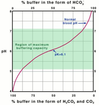LEC1: pH and Buffers Flashcards
where can a buffer be useful?
+/- 1 pH unit around the pKa
formula for dissociation constant of an acid?

how do weak acids/abses act as buffers?
weak acids & bases only partially dissociate into charged species
buffers provide a reservoir of acid that consumes added base, reservoir of base that consumes added acid
therefore dampen pH changes
what do acids and bases tend to do, what is each’s effect on pH?
acids donate protons, cause a decrease in pH
bases accept protons, cause an increase in pH by removing protons from H2O
what do acids/bases each do re: proton exchange?
acids donate protons
bases accept protons
what is pH for pure water under normal conditions?
pH = 7
what is the definition of pH?
pH = -log[H+]
pH is the measure of the H+ion concentration
what is the effect of buffers on pH?
buffers dampen pH changes
what is the Ka?
dissociation constant of an acid
what does this curve show?

concentration curve for buffer
shows relationship between acid added/base added (x axis) & pH (y axis)
see small changes to pH when add base (to the R) or acid (to the L) because this is where buffer is useful
see if add a LOT of base or acid, the conjugate acid/base is exhausted, buffer is no longer useful as a buffer
what is Henderson-Hasselbach equation?

what is the pKa of a weak acid?
the pH at which 1/2 of the molecules are dissociated into ions
what is the maximum buffering capacity of a weak acid?
1 pH unit above/below the pKa
here, both acid and conjugate base are present, can consume added ions
how is an acid and a base when each is above its pKa?
acid above its pka: unprotonated, charged
base above its pKa: unprotonated, neutral
what buffers human blood?
bicarbonate buffering system
what is the Henderson-Hasselbach equation for the formation of bicarbonate?

what does this graph represent?

titration curve of carbonic acid/bicarbonate system
pH = 6.1 is known neutral state; see that between pH=5.1-7.1, small changes in pH
what is the pH of blood?
7.4
at physiologic pH of blood, what is ratio of bicarbonate:carbonic acid? explain
[H2CO3] to [HCO3-] is 1:20
physiological mechanisms can regulate this concentration
1) [H2CO3] modulates with breathing rate, affecting CO2levels in the blood - rxn becomes more acidic
2) [HCO3-] modulates by changing the rate of its elimination by the **kidney **- rxn becomes more basic
when does a drug get absorbed?
if a drug is a weak acid, aka **protonated & uncharged, **it can be absorbed into the stomach
describe how aspirin works, the form its found in in the stomach
pH of the stomach = 1.5
aspirin is a weak acid, pH= 3.5
therefore at pH = 1.5, aspirin will be protonated and uncharged, and therefore can cross membrane > stomach & intestines
protonated form is 100x more abundant than charged form
what is charge of each part of an amino acid? & what is amino acid’s charged at pH=7?
weakly basic amino group, pKa = 9-10
weakly acidic carboxyl group, pKa = 2
overall, at pH=7, charge of an amino acid=0
structure of an amino acid?

what does it mean that amino acids are optical isomers?
their stereoisomers are nonsuperimposable mirror images
what is the simplest amino acid? how is it found in nature?
glycine; R group = H
overall charge is positive, both groups are protonated, if in highly acidic environment
overall charge is **neutral **in physiologic form (normal!)
overall charge is negative, both groups are unprotonated, if in highly basic environment
what is this? explain what is happening

represents the acidic/basic propteries of an amino acid w/ an uncharged R-group, aka glycine
see 2 regions where it behaves as a buffer:
1) pK1, the pKa of carboxyl group
2) pK2, the pKa of the amino group
what is the isoelectric point?
the pH in which the amino acid is electrically neutral - charges balance
what is the pI of amino acids w/ R groups that cannot be ionized?
6
how are amino acids re: protonation, charge, at physiological pH?
carboxyl group is unprotonated, negative charged
amino group is protonated, positively charged
how does the body control the level of CO2 in blood?
[H2CO3] modulates with breathing rate, affecting CO2 levels in the blood
Henderson-Hasselbalch rxn becomes more acidic
how does the body control bicarbonate concentration?
[HCO3-] modulates by changing the rate of its elimination by the kidney
H-H rxn becomes more basic
how does a buffer reduce the effect of added acid or base on the pH of a solution?
buffers dampen pH changes by providing a reservoir of acid that consumes added base / a reservoir of base that consumes added acid
at +/- 1 pH unit above or below a weak acid’s pKa, added ions are consumed by buffer
why is the maximum buffering capacity of a weak acid at +/- 1 pH unit of its pKa?
because in this pH range both the acid and its conjugate base are present and can consume the added ions
is a weak acid charged or uncharged at 2 pH units above its pKa?
charged
is a weak base charged or uncharged at 2 pH units above its pKa?
neutral
why is the carbonic acid/bicarbonate system an effective buffer of blood even though its combined pKa is more than 1 more pH unit below that of blood pH?
the combined pKa of carbonic acid/bicarbonate = 6.1
blood pH=7.4
works b/c components can be regulated by physiological mechanisms


